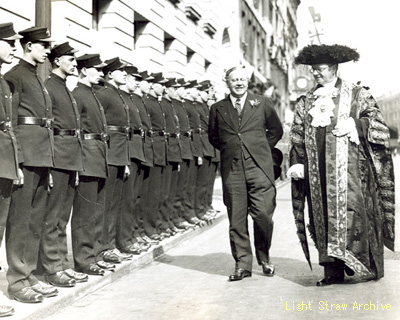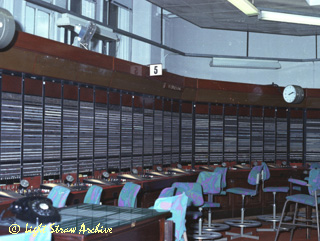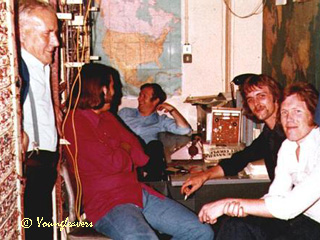...on the site of GPO South.
 |
"The opening of Faraday Building marks an important stage in British Post Office development and is a considerable event in telephone history. My Lord Mayor, I think I can say, that we are indeed, living in an age of miracles. Today by lifting the receiver of a telephone in London, a British subscriber can speak to Canada, the United States, South America, Australia, South Africa and nearly every other country, except China and Japan." |
| | EXIT | Faraday International | Faraday ISC | Faraday ICC | Progress in Switching | The End | Terms | | |
The International Telephone Exchange was opened by the Lord Mayor of London, Sir Percy Greenaway, at a ceremony which took place at 4pm on 4th May 1933. The exchange, a sleeve-control board of 121 positions, had been installed on the 1st floor of the North Block. The new South Block a building of 11 storeys, linked to the existing North Block by bridges and subways was opened at the same time.
British Pathe Newsreel (1933)
A short news film made by British Pathe has recorded the event...
Full title reads: "London: The World's Switchboard' Lord Mayor opens International Telephone Exchange - one of the wonders of the World and an all-British triumph! World's 32 million telephone subscribers can now speak to each other, with exception of Albania, China and Japan."
Postmaster General, Sir Kingsley Wood MP, makes a speech greeting the Lord Mayor of London to the Faraday Building, the home of the new International Exchange. He explains the wonders of the new exchange:
" The opening of Faraday Building marks an important stage in British Post Office development and is a considerable event in telephone history. My Lord Mayor, I think I can say, that we are indeed, living in an age of miracles. Today by lifting the receiver of a telephone in London, a British subscriber can speak to Canada, the United States, South America, Australia, South Africa and nearly every other country, except China and Japan."
The Lord Mayor makes a speech about the importance of personal contact in smooth the wheels of industry:
"Every businessman knows how valuable personal discussion can be in the conduct of affairs; here in a world-wide telephone service provided by the Post Office is the means at hand for introducing this personal contact and thus smoothing the wheels of industry. I have the greatest pleasure in declaring this building and new exchange open."
He turns the switch to start the exchange working. He then lift the telephone receiver and says:
"Will you please give me the new international exchange?"
| Faraday ICC | |
 |
Faraday ICC opened on the 1st floor of the North Block on 4th May 1933 as a sleeve-control board of 121 positions; 93 Continental and 28 Radio working. The Radio Telephony Terminal (RTT) was situated on the same floor. |
Peter Walker writes..."Faraday ISC - A quite unique Strowger technology switch, extended 17 times - the last (Transit MF2 access) having to be outhoused in Wren House due to lack of room in Faraday."
Faraday International Switching Centre opened in 1964 and used Strowger switching to route calls. In common with later ISCs, it also had...
- An IMC, International Maintenance Centre.
- A Repeater Station.
- An IATAE, International Accounting and Traffic Analysis Equipment.
- An ICC, International Control Centre for handling operator connected
calls.
 |
|
| Progress in Switching | |
- In 1959/1960 TASI (Time Assignment Speech Interpolation)
equipment.
- In 1963 the first ISD call to Paris in 1963 used
converted AC9 signalling from the Type 4 RTs (Register
translators) - before Faraday ISC opened.
- 1964 Faraday ISC opened.
- In 1971, the traffic capacity of the Faraday ITCS was
almost doubled by the use of 'marker splitting.'
Previously, switching equipment was designated to fixed
routes and the new technique allowed free equipment to be
used for whichever destination needed the additional
circuits. This was possible due to the time differences
across the world; circuits on routes that were busy during
our daytime, might be free during the night and thus used to
route calls to other countries.
- Also in 1971, Bell SF (Single Frequency) signalling
units were installed in Faraday so that additional circuits
to the USA could be brought into service. The units were
used to convert loop-disconnect pulses to 2.6kHz signals for
transmission on the overseas network. Outgoing access from
London was via the sleeve control LD relay sets of the
international manual boards in Wren House to the SF
equipment in Faraday. Incoming access from the States manual
board was again via the SF circuits converting the a.c
signals back to d.c. pulses suitable for the UK's inland
network.
- Signalling systems played a major role in the continuing
development of both STD and ISD and over the years, many
different conventions were adopted to deal with the varying
types of signalling from one country to another.
Faraday ISC closed at the end of 1980.
Terms
ICC International Control Centre
ISC International Switching Centre
IDD International Direct Dialling
ISD International Subscriber Dialling
TASI Tme Assignment Speech Interpolation
Design, images and text compiled by ©
Light-Straw. With thanks to Peter
Walker.
Page last updated 6th February 2011. Checked May 2021.
All logos and
trade marks are the property of their respective owners and are used on
the Light Straw site(s) for review only. Students and researchers are
recommended to make their own independent enquiries as to the accuracy
of the information contained therein.